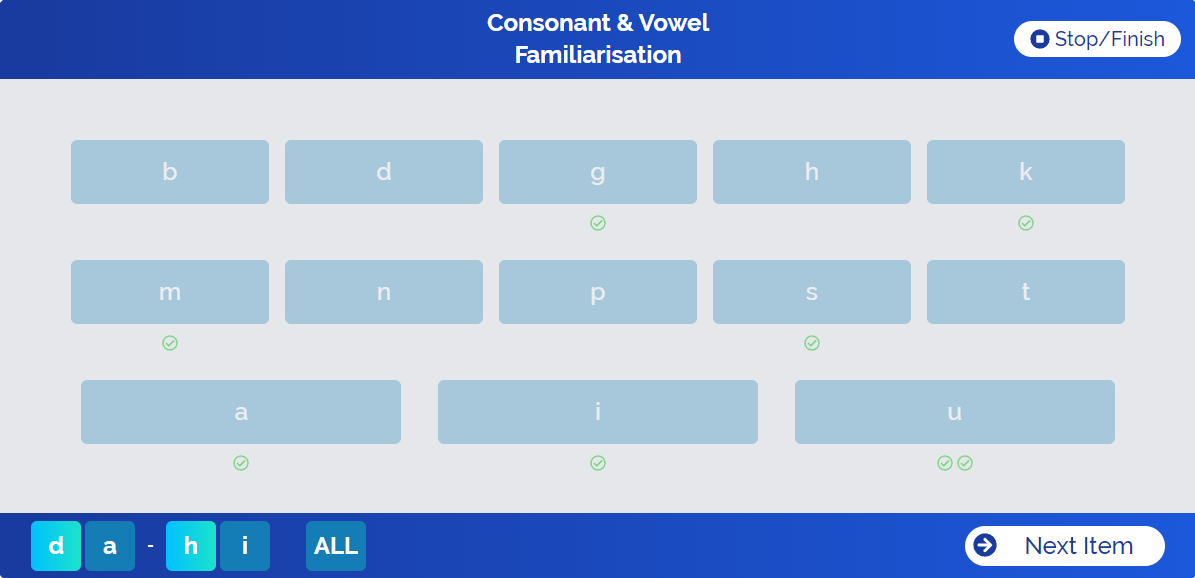The Listening in Spatialized Noise – Universal Test (LiSN-U)
Appropriate for age 6 and over
The LISN-U is a test of speech (nonsense syllable) understanding in noise (competing speech, also nonsense syllables). The speech stimuli, which are all spoken by the same female speaker, are synthesised with head-related transfer functions to create a three-dimensional auditory environment over headphones. The LiSN-U has two subtests. The first subtest (spatially-separated condition) measures understanding when the talker is directly in front of the listener, but the competing speech comes from the left and right. In the second subtest (co-located condition), the target and competing speech all come from directly in front of the listener. Like the Listening in Spatialized Noise – Sentences test (LiSN-S), LiSN-U assesses both overall speech-in-noise ability and whether any overall deficit found is caused by a spatial processing disorder (SPD). SPD is a deficit in the ability to use the spatial separation of different sound sources to understand a target frontal talker.
The condition is a relatively common cause of speech in noise deficits that do not have their origins in cognitive or language problems, and is a frequent long-term consequence of protracted or repeated otitis media in the first five years of life. SPD can be effectively remediated by training speech perception in spatially separated noise. The LiSN-U stimuli are spoken with an Australian accent, but as the stimuli are nonsense syllables that use phonemes found in almost any language, it is believed to be suitable for talkers of almost any language. The stimuli have been normalized for equal intelligibility based on research conducted in listeners from a range of language backgrounds. The extensive normative data built into the test are based on measurements on Australian children and adults. The test expresses all scores relative to normative data.

Published Science
Sevmez, H. S., Yücel, H. M., Işık, İ., Odabaşı, Y., Türkyılmaz, M. D., Cameron, S., & Dillon, H. (2025). The non-effect of language on the Listening in Spatialised Noise – Universal (LiSN-U) test: performance with Turkish speakers. International Journal of Audiology, 1–8. https://doi.org/10.1080/14992027.2025.2518544
Dillon, H., & Cameron, S. (2021). Separating the Causes of Listening Difficulties in Children. Ear & Hearing, 42 (5):1097–1108. https://doi.org/10.1097/AUD.0000000000001069.
Mealings, K., & Dillon, H. (2021). English language and language-free detection of spatial processing disorders in Aboriginal and Torres Strait Islander children. International journal of audiology, 60(9), 704–710. https://doi.org/10.1097/AUD.0000000000001069
Mealings, K., Cameron, S., Chong-White, N., Young, T., & Dillon H. (2021). Listening in Spatialized Noise - Universal Test (LiSN-U) test-retest Reliability study. International Journal of Audiology. International Journal of Audiology, 60 (1):75-80. https://doi.org/10.1080/14992027.2020.1795283.
Cameron S., Mealings K., Chong-White N., Young T., & Dillon H. (2020). The development of the listening in spatialised noise – universal test (LiSN-U) and preliminary evaluation in English-speaking listeners. International Journal of Audiology, 59 (4):263-271. https://doi.org/10.1080/14992027.2019.1689431
Mealings, K., Cameron, S., & Dillon H. (2020). Correlating performance on the Listening in Spatialized Noise - Sentences Test (LiSN-S) with the Listening in Spatialized Noise - Universal Test (LiSN-U). International Journal of Audiology, 59 (7):519–523. https://doi.org/10.1080/14992027.2020.1753119
Mealings, K., & Harkus, S. (2020). Remediating spatial processing disorder in Aboriginal and Torres Strait Islander children. International journal of pediatric otorhinolaryngology, 137, 110205. https://doi.org/10.1016/j.ijporl.2020.110205
